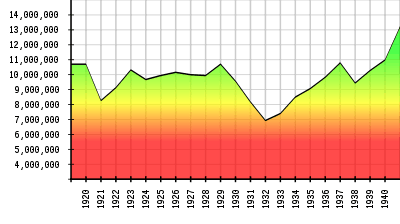Recession of 1937–38

The Recession of 1937–1938 was an economic downturn that occurred during the Great Depression in the United States.
By the spring of 1937, production, profits, and wages had regained their 1929 levels. Unemployment remained high, but it was slightly lower than the 25% rate seen in 1933. The American economy took a sharp downturn in mid-1937, lasting for 13 months through most of 1938. Industrial production declined almost 30 percent and production of durable goods fell even faster.
Unemployment jumped from 14.3% in 1937 to 19.0% in 1938.[1] Manufacturing output fell by 37% from the 1937 peak and was back to 1934 levels.[2] Producers reduced their expenditures on durable goods, and inventories declined, but personal income was only 15% lower than it had been at the peak in 1937. In most sectors, hourly earnings continued to rise throughout the recession, which partly compensated for the reduction in the number of hours worked. As unemployment rose, consumers expenditures declined, thereby leading to further cutbacks in production.
Response

The Roosevelt Administration reacted by launching a rhetorical campaign against monopoly power, which was cast as the cause of the depression, and appointing Thurman Arnold in the anti-trust division of the U.S. Department of Justice to act, but Arnold was not effective. In February 1938, Congress passed a new AAA bill, the Agricultural Adjustment Act of 1938, which authorized crop loans, crop insurance against natural disasters, and large subsidies to farmers who cut back production. On April 2, Roosevelt sent a new large-scale spending program to Congress, and received $3.75 billion which was split among Public Works Administration (PWA), Works Progress Administration (WPA), and various relief agencies.[3] Other appropriations raised the total to $5 billion in the spring of 1938, after which the economy recovered.
Some economists believed that banking reforms already enacted were insufficient and that further reforms were warranted. Many suggestions put forward by Chicago economists in two 1933 memoranda that came to be known as the Chicago plan, were resurrected and recirculated in a 1939 draft proposal entitled A Program for Monetary Reform.
Recovery
Although the American economy recovered in mid-1938, employment did not regain the 1937 level until the United States entered World War II in late 1941. Personal income in 1939 was almost at 1919 levels in aggregate, but not per capita. The farm population had fallen 5%, but farm output was up 19% in 1939.
Employment in private sector factories regained the levels reached in 1929 and 1937, but did not exceed them until the onset of World War II. Productivity steadily increased, and output in 1942 was well above the levels of both 1929 and 1937.
Interpretations
Economists disagree about the causes of this downturn.
- Keynesian economists assign blame to cuts in federal spending and increases in taxes at the insistence of the US Treasury.[4] Historian Robert C. Goldston also noted that two vital New Deal job programs, the Public Works Administration and Works Progress Administration, experienced drastic cuts in the budget which Roosevelt signed into law for the 1937-1938 fiscal year.[5]
- Monetarists, such as Milton Friedman, assign blame to the Federal Reserve's tightening of the money supply in 1936 and 1937.[6]
- Contrary to the monetarist assumption, Austrian School economist Johnathan Catalan assigns blame to the relatively large expansion of the money supply from 1933 to 1937. He also notes that the money supply did not tighten until after the recession began.[7]
See also
Notes
- ↑ Economic Fluctuations, Maurice W. Lee, Chairman of Economics Dept., Washington State College, published by R. D. Irwin Inc, Homewood, Illinois, 1955, page 236.
- ↑ Business Cycles, James Arthur Estey, Purdue Univ., Prentice-Hall, 1950, pages 22-23 chart.
- ↑ The Great Depression, Robert Goldston, page 229
- ↑ About the Great Depression Paul Krugman, November 8, 2008
- ↑ Robert Goldston (1968). The Great Depression. Fawcett Publications. p. 228. Retrieved 28 September 2013.
- ↑ The Great Depression: an international disaster of perverse, Pages 148-149
- ↑ Finegold Catalan, Jonathan M. (2 February 2010). "Dangerous Lessons of 1937". Mises.org. Ludwig von Mises Institute. Retrieved 11 August 2011.
References
- Alan Brinkley. The End Of Reform: New Deal Liberalism in Recession and War. (1995)
- John J. Coleman. "State Formation and the Decline of Political Parties: American Parties in the Fiscal State" Studies in American Political Development 1994 8(2): 195-230. ISSN 0898-588X
- Walter Galenson. The CIO Challenge to the AFL: A History of the American Labor Movement, 1935-1941 Harvard University Press, 1960
- Robert Goldston. The Great Depression: The United States in the Thirties, Fawcett Publications, 1968
- D. A. Hayes, "Business Confidence and Business Activity: A Case Study of the Recession of 1937," Michigan Business Studies v 10 #5 (1951)
- Patrick D. Reagan. Designing a New America: The Origins of New Deal Planning, 1890-1943 University of Massachusetts Press, 2000
- Kenneth D. Roose. "The Recession of 1937-38" Journal of Political Economy, Vol. 56, No. 3 (Jun., 1948), pp. 239–248
- Kenneth D. Roose. The Economics of Recession and Revival; an Interpretation of 1937-38 (1954)
- Richard Ruggles. An Introduction to National Income and Income Analysis 1949.
- Sumner H. Slichter. "The Downturn of 1937" Review of Economic Statistics 20 (1938) 97-110
- Velde, François R. "The recession of 1937—A cautionary tale." Economic Perspectives 33, no. 4 (2009): 16-37.